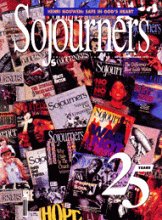It's 4:20 p.m. I'm standing over the Olympic soccer stadium in Sarajevo. From one goal post to the other are graves-headstones of various sizes and shapes, most unmarked. There is an IFOR base where the concession stands once stood, with tanks, humvees, jeeps, and corrugated metal Quonset hut barracks. The graves are offside, I think. They go on up the hill.
Almost as soon as we arrive at the stadium the word comes that we must leave immediately for the airport to "meet the Serbs." Father Ivo Markovic, our host in Sarajevo, has arranged the meeting. Our group divides, some staying on at the stadium, some racing to the airport for the 4:30 p.m. rendezvous. I go for "the Serbs."
On the way we pass the bombed Franciscan Theological School where Father Ivo was taken prisoner and Sister Isadora served tea to her captors. We are detoured at the hole in the road where Asim Fazzic, who I met earlier at the Bread of St. Anthony soup kitchen, was shelled and pinned under machine gun fire one morning on his way to work. He ran the printing press for the Oslobodenje newspaper for 41 years until his injuries stopped him. We near the airport where a few lucky ones escaped the siege of Sarajevo through the tunnel under the tarmac; most were shot on the runway by NATO troops or others under orders to hold the line.
It's 4:40 pm. We arrive at a police installation just past the airport. Father Ivo is there. (His car now has "new" license plates so as not to attract unwanted attention.) We are not just to "meet the Serbs," but to be escorted to Pale-the government stronghold of the provisional Republika Srpska and home of Radovan Karadzic, accused by the International Criminal Tribunal of "almost unparalleled acts of cruelty."
Read the Full Article

